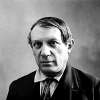Maqbool
Husain
Maqbool Husain, a Modernist figure in Indian art, is celebrated for his vibrant narrative paintings, blending tribal and mythological themes. If you're looking for original Maqbool Husain works for sale or would like to sell, request a complimentary valuation and explore our network's most in-demand pieces.
Notable series
Maqbool Husain art for sale
Discover Maqbool Husain prints for sale, exclusively available through our private network of collectors. Explore signed and unsigned screenprints, lithographs, digital prints, and rare editioned proof prints by era-defining blue chip artists.
Sell Your Art
with Us
with Us
Join Our Network of Collectors. Buy, Sell and Track Demand
Biography
Maqbool Husain, was a leading figure in Modern Indian art, whose work reshaped South Asian aesthetics in the 20th century. Husain's vivid, bold, and often controversial artworks tell stories of his homeland, weaving together its history, religion, and culture into a striking visual language.
Born on 17th September 1915 in Pandharpur, Maharashtra, Husain's journey into the art world was initiated by a fascination for cinema and calligraphy, foreshadowing the dynamic motion and sweeping lines that would characterise his later works. He studied at Sir J.J. School of Art in Bombay, where he emerged as a pivotal figure in the Bombay Progressive Artists' Group. Founded in 1947, the group aimed to develop an Indian form of Modernism that celebrated traditional Indian painting and nodded to the innovative art movements in Europe and America.
Husain's artistry is marked by distinct phases, each reflective of his personal growth and India’s societal landscape. His early works were deeply rooted in the narrative tradition, employing a modified Cubist style to depict the rhythm and vibrancy of Indian life. As his career progressed, Husain's subjects ranged from Indian deities to the exuberant energy of Indian cities, all portrayed with his signature of bold colours and fluid lines.
The artist's collaborations and influences were varied, drawing inspiration from Indian mythology, religious iconography, and Modernism. Husain's interactions with European artists during his travels contributed to the eclectic nature of his oeuvre.
Husain's exhibitions have marked milestones in the history of Modern Art. His works have been showcased in prestigious venues including the São Paulo Biennial, the Venice Biennale, and the Royal Academy of Arts in London. He was also the recipient of numerous accolades, including the Padma Bhushan and the Padma Vibhushan, India's second-highest civilian award.
Despite facing controversy and legal challenges in India for his often provocative depictions of Hindu deities, Husain’s uncompromising exploration of cultural motifs have solidified his status as a visionary who transcended the boundaries of traditional Indian art.
On the 9th of June, 2011, Husain died in London, leaving behind a Modernist body of work defined by its vibrant celebration of Indian identity.






















